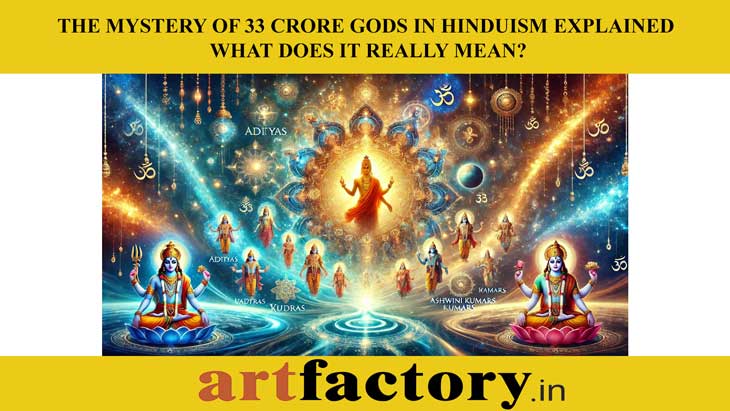
The Mystery of 33 Crore Gods in Hinduism Explained – What Does It Really Mean?
Hinduism, one of the world's oldest religions, is often associated with the belief in 33 crore (330 million) gods. This number has intrigued and mystified believers and scholars alike. But is Hinduism truly a polytheistic religion with millions of deities, or is there a deeper, symbolic meaning behind this widely quoted figure? Let’s explore the truth behind this fascinating concept.
The Origin of 33 Crore Gods in Hinduism
The phrase “33 crore gods” is a common interpretation of ancient Hindu scriptures. However, a closer look at the Vedic texts reveals that the original reference is to 33 supreme deities, not 33 crore. The misunderstanding arises due to a translation error between 'koti', which means 'types' or 'categories' in Sanskrit, and 'crore' (10 million in Indian numerals).
Who Are the 33 Supreme Deities?
According to the Brihadaranyaka Upanishad and the Yajurveda, Hinduism originally spoke of 33 primary deities, categorized as follows:
12 Adityas – Represent the different aspects of time and cosmic cycles.
11 Rudras – Symbolize transformation and destruction, aspects of Lord Shiva.
8 Vasus – Represent natural elements like fire, earth, water, and wind.
2 Ashwini Kumars – Celestial twin gods known for healing and medicine.
These 33 Vedic gods are considered cosmic forces that govern the universe rather than individual anthropomorphic deities.
Why Do People Say 33 Crore Gods Exist?
Over time, Hinduism evolved with countless sects, traditions, and localized deities. The vast diversity of gods emerged as different forms, manifestations, and incarnations of the one ultimate reality—Brahman. Devotees personalized gods based on regions, traditions, and spiritual needs, leading to a vast pantheon of deities.
Additionally, Hindu philosophy teaches that divinity exists in everything—every rock, tree, river, animal, and human being. This belief extends to the idea that there are as many gods as there are beings in the universe, reinforcing the idea of 33 crore (330 million) gods as a metaphor for infinite divine manifestations.
Hinduism – Monotheistic, Polytheistic, or Something Else?
Hinduism is unique because it accommodates multiple perspectives. It recognizes one supreme reality (Brahman) that manifests in many forms. Different deities like Vishnu, Shiva, Durga, Ganesha, and Lakshmi are considered various expressions of the same divine power. Thus, Hinduism is neither strictly monotheistic nor polytheistic but rather henotheistic—worshipping one supreme deity while acknowledging the existence of many divine forms.
The Spiritual Significance of 33 Koti Deities
Understanding the symbolism behind the 33 koti deities can enrich our spiritual perspective:
Unity in Diversity – Hinduism accepts all paths to the divine, whether through devotion (bhakti), knowledge (jnana), or action (karma).
Nature and the Divine – The 33 deities embody cosmic and natural forces, reminding us to respect the environment and universal laws.
Personal Connection to the Divine – Hinduism allows individuals to relate to God in any form they choose, fostering a deep personal spiritual experience.
Conclusion: The True Essence of Hindu Deities
The mystery of 33 crore gods in Hinduism is not about literal numbers but about the infinite ways divinity can manifest. Whether you worship Lord Krishna, Goddess Durga, Lord Shiva, or any other deity, the ultimate truth remains the same—all paths lead to the same divine consciousness. This vast, inclusive, and deeply philosophical approach makes Hinduism one of the most spiritually enriching traditions in the world.
So, the next time someone asks about the 33 crore gods, you can share the profound wisdom behind this age-old concept!
Did you find this explanation fascinating? Share this blog with others and spark a meaningful conversation on Hindu spirituality!
Q1: Does Hinduism really have 33 crore (330 million) gods?
A: No, the idea of 33 crore gods is a misunderstanding. Ancient Hindu scriptures refer to 33 primary deities, not 33 crore. The confusion arises from the Sanskrit word "koti", which means 'types' or 'categories', but was misinterpreted as 'crore' (10 million).
Q2: Who are the original 33 deities mentioned in Hindu texts?
A: The 33 deities are divided into four categories:
12 Adityas – Represent different aspects of time and the sun.
11 Rudras – Forms of transformation and destruction, linked to Shiva.
8 Vasus – Symbolizing natural elements like fire, water, and wind.
2 Ashwini Kumars – Celestial twins known for healing and medicine.
Q3: Why do Hindus worship so many gods if there is only one Supreme Reality?
A: Hinduism teaches that one Supreme Reality (Brahman) manifests in infinite forms. Different gods are various aspects of the same divine energy, making the religion inclusive and adaptable to personal devotion.
Q4: Is Hinduism polytheistic, monotheistic, or something else?
A: Hinduism is best described as henotheistic, meaning it acknowledges one Supreme Reality while allowing the worship of multiple divine forms.
Q5: What is the spiritual significance of the 33 deities?
A: The 33 deities represent universal forces that govern nature and cosmic laws. They symbolize the balance of life, time, and the elements, encouraging respect for both spiritual and natural order.
Q6: Why do people believe there are 330 million gods in Hinduism?
A: Over time, as Hinduism evolved, people created personalized deities based on regions, traditions, and spiritual beliefs. Since Hinduism recognizes divinity in everything, the idea of infinite manifestations led to the belief in 330 million gods.
Q7: Can one worship just one deity in Hinduism?
A: Yes, Hindus can choose to worship any deity they feel spiritually connected to, as all gods ultimately lead to the same divine truth (Brahman).
Q8: What should I tell someone who asks about 33 crore gods?
A: Explain that Hinduism originally spoke of 33 deities, not 33 crore. The misunderstanding comes from a translation error, and the number 33 symbolizes cosmic forces rather than an actual count of gods.

Comments : (0)